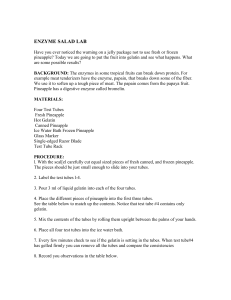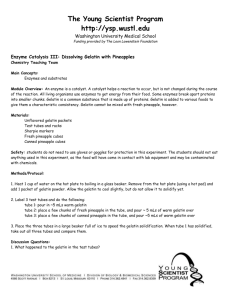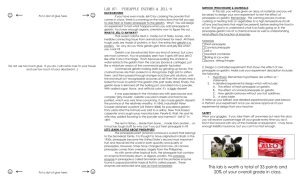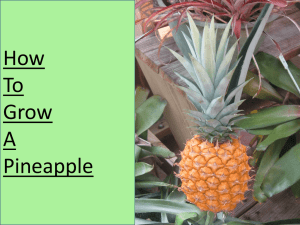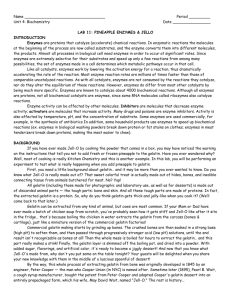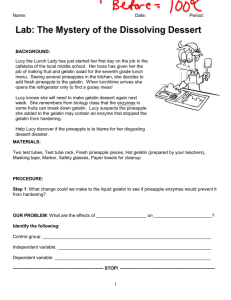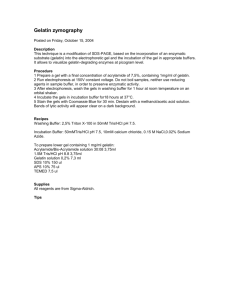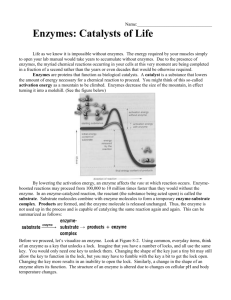lab 8: pineapple enzymes & jello molds background
advertisement
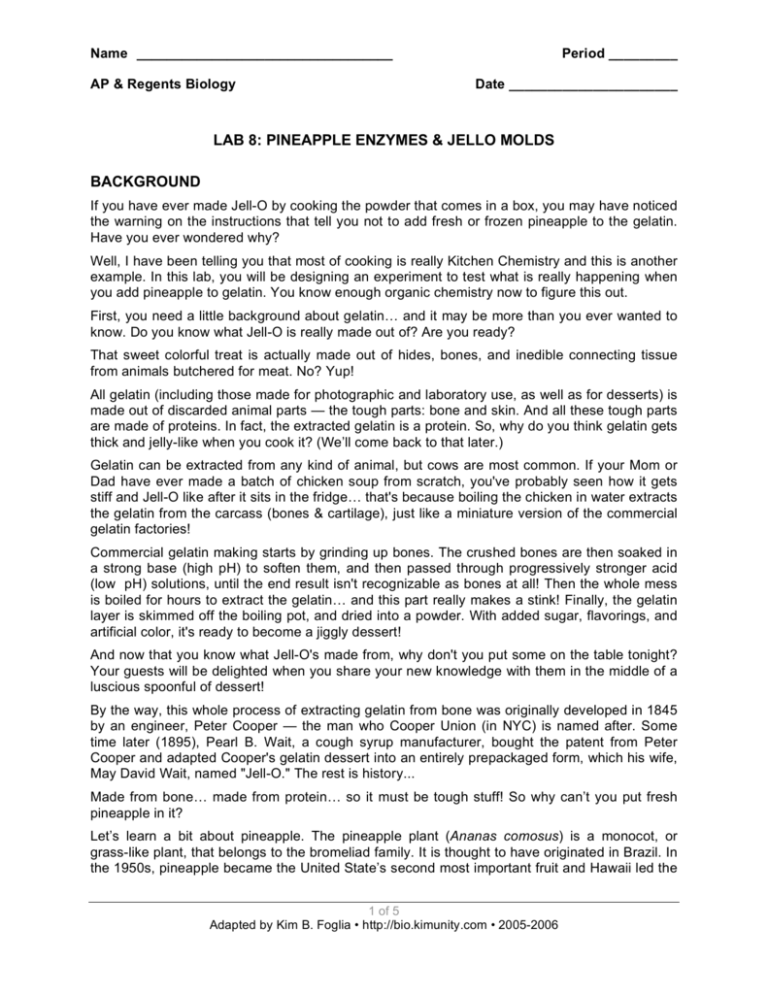
Name __________________________________ AP & Regents Biology Period _________ Date ______________________ LAB 8: PINEAPPLE ENZYMES & JELLO MOLDS BACKGROUND If you have ever made Jell-O by cooking the powder that comes in a box, you may have noticed the warning on the instructions that tell you not to add fresh or frozen pineapple to the gelatin. Have you ever wondered why? Well, I have been telling you that most of cooking is really Kitchen Chemistry and this is another example. In this lab, you will be designing an experiment to test what is really happening when you add pineapple to gelatin. You know enough organic chemistry now to figure this out. First, you need a little background about gelatin… and it may be more than you ever wanted to know. Do you know what Jell-O is really made out of? Are you ready? That sweet colorful treat is actually made out of hides, bones, and inedible connecting tissue from animals butchered for meat. No? Yup! All gelatin (including those made for photographic and laboratory use, as well as for desserts) is made out of discarded animal parts — the tough parts: bone and skin. And all these tough parts are made of proteins. In fact, the extracted gelatin is a protein. So, why do you think gelatin gets thick and jelly-like when you cook it? (We’ll come back to that later.) Gelatin can be extracted from any kind of animal, but cows are most common. If your Mom or Dad have ever made a batch of chicken soup from scratch, you've probably seen how it gets stiff and Jell-O like after it sits in the fridge… that's because boiling the chicken in water extracts the gelatin from the carcass (bones & cartilage), just like a miniature version of the commercial gelatin factories! Commercial gelatin making starts by grinding up bones. The crushed bones are then soaked in a strong base (high pH) to soften them, and then passed through progressively stronger acid (low pH) solutions, until the end result isn't recognizable as bones at all! Then the whole mess is boiled for hours to extract the gelatin… and this part really makes a stink! Finally, the gelatin layer is skimmed off the boiling pot, and dried into a powder. With added sugar, flavorings, and artificial color, it's ready to become a jiggly dessert! And now that you know what Jell-O's made from, why don't you put some on the table tonight? Your guests will be delighted when you share your new knowledge with them in the middle of a luscious spoonful of dessert! By the way, this whole process of extracting gelatin from bone was originally developed in 1845 by an engineer, Peter Cooper — the man who Cooper Union (in NYC) is named after. Some time later (1895), Pearl B. Wait, a cough syrup manufacturer, bought the patent from Peter Cooper and adapted Cooper's gelatin dessert into an entirely prepackaged form, which his wife, May David Wait, named "Jell-O." The rest is history... Made from bone… made from protein… so it must be tough stuff! So why can’t you put fresh pineapple in it? Let’s learn a bit about pineapple. The pineapple plant (Ananas comosus) is a monocot, or grass-like plant, that belongs to the bromeliad family. It is thought to have originated in Brazil. In the 1950s, pineapple became the United State’s second most important fruit and Hawaii led the 1 of 5 Adapted by Kim B. Foglia • http://bio.kimunity.com • 2005-2006 Name __________________________________ Period _________ world in both quantity and quality of pineapples. However, times have changed and now, all canned pineapple comes from overseas, largely from the Philippines. As with some other tropical fruits, the pineapple fruit contains an enzyme that breaks down, or digests, protein. This protease (protein-digesting) enzyme in pineapple is called bromelain, which is extracted and sold in such products as Schilling's Meat Tenderizer. Papaya, another tropical fruit, also contains an enzyme, called papain, that digest protein. It can be found in Accent Meat Tenderizer. PROCEDURE: In this lab, you will be given an array of materials and you will be asked to design your own experiment to test the effect of pineapple on gelatin. The goal is to understand what is actually going on in the pineapple-gelatin mix at a chemical level as well as understanding what affects the fuction of enzymes. 1. You will be given the following materials • Fresh pineapple • Canned pineapple • Frozen pineapple • Jell-o • Beakers • Boiling & ice water • Test tubes & rack • Spoons, stirring rods • Knife for chopping pineapple 2. Design a controlled experiment that shows the effect of raw pineapple on gelatin. Make sure your experiment description includes the following: a. An hypothesis. Remember hypotheses are written as “If…then” statements. b. A detailed experimental design which will include: 1. The effect of fresh pineapple on gelatin. 2. The effect of frozen pineapple on gelatin. 3. The effect of canned pineapple on gelatin. 4. The effect of freshly cooked pineapple on gelatin. 5. A test to determine how gelatin behaves without any additives. c. A data table 3. Write up a detailed experimental plan on the accompanying sheet of paper. 4. You will be abe to perform your experiment once you receive approval of your experiemental design from your teacher. 2 of 5 Adapted by Kim B. Foglia • http://bio.kimunity.com • 2003-2004 Name __________________________________ Period _________ EXPERIMENTAL DESIGN GUIDE Teacher Approval_________ TITLE _______________________________________________________________________ _____________________________________________________________________________ _____________________________________________________________________________ HYPOTHESIS ________________________________________________________________ _____________________________________________________________________________ _____________________________________________________________________________ _____________________________________________________________________________ INDEPENDENT VARIABLE _____________________________________________________ MEASUREMENT OF INDEPENDENT VARIABLE NUMBER OF TRIALS DEPENDENT VARIABLE _______________________________________________________ MEASUREMENT OF DEPENDENT VARIABLE _____________________________________ _____________________________________________________________________________ _____________________________________________________________________________ CONTROL ___________________________________________________________________ OTHER CONTROLLED FACTORS (AT LEAST 5) ___________________________________ _____________________________________________________________________________ _____________________________________________________________________________ 3 of 5 Adapted by Kim B. Foglia • http://bio.kimunity.com • 2003-2004 Name __________________________________ Period _________ QUESTIONS 1. Clearly describe the results of your experiment. In which test tubes did the gelatin jell, which did not. 2. Clearly explain the results of your experiment. Why did some test tubes of gelatin jell, why did others not. Be specific! 3. What is the enzyme in your experiment? 4. What is the substrate in your experiment? 5. What is (are) the product(s) in your experiment? 6. What type of organic molecule is gelatin? 7. What type of organic molecule is bromelain? 8. Write a “word equation” to describe the chemical reaction that occurs when pineapple is mixed with the gelatin. 9. Is the reaction of bromelain and gelatin dehydration synthesis or hydrolysis? Explain. 10. Why were the results of the freshly cooked pineapple different than the results of the fresh, raw pineapple? Be specific! 11. What is meat tenderizer and what does it do? 12. On the accompanying sheet of paper, design an experiment to test at what specific temperature the pineapple enzyme denatures. 4 of 5 Adapted by Kim B. Foglia • http://bio.kimunity.com • 2003-2004 Name __________________________________ Period _________ EXPERIMENTAL DESIGN GUIDE TITLE _______________________________________________________________________ _____________________________________________________________________________ _____________________________________________________________________________ HYPOTHESIS ________________________________________________________________ _____________________________________________________________________________ _____________________________________________________________________________ _____________________________________________________________________________ INDEPENDENT VARIABLE _____________________________________________________ MEASUREMENT OF INDEPENDENT VARIABLE NUMBER OF TRIALS DEPENDENT VARIABLE _______________________________________________________ MEASUREMENT OF DEPENDENT VARIABLE _____________________________________ _____________________________________________________________________________ _____________________________________________________________________________ CONTROL ___________________________________________________________________ OTHER CONTROLLED FACTORS (AT LEAST 5) ___________________________________ _____________________________________________________________________________ _____________________________________________________________________________ 5 of 5 Adapted by Kim B. Foglia • http://bio.kimunity.com • 2003-2004
